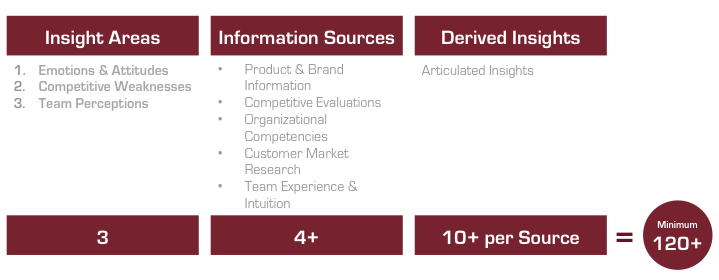Insights: Positioning's Critical Foundation
OK, so you’ve kicked off a positioning effort and have thoroughly dissected the needs of your potential customers, isolated a unique insight that none of your competitors recognize, and are poised to develop the most differentiating and tantalizing positioning your market has ever seen--outstanding!
Wait, you’re not sure the insight is that unique? You worry that your competitors may actually understand it or may even be using it as the basis for their positioning? Then you may have a real problem on your hands.
If this scenario sounds familiar, don’t panic, you aren’t alone. In fact, you’re in the company of the vast majority of marketers and market researchers attempting to position their products. The truth is, many brand positioning strategies are rather mundane—the insight each is built on either isn’t unique and relevant, or isn’t actually an insight at all. It is fair to say that anyone who has attempted to position a brand realizes the fundamental importance of identifying insights as a basic tenet to creating an effective brand position. The question becomes, how do you identify the unique insight that will provide the best opportunity for effective brand positioning?
Let’s start by identifying two major issues surrounding insight identification as they relate to the development of brand positioning strategy. First – useful, behavior-changing insights are obscure. You cannot simply walk up to a potential customer, ask them to tell you what affects their purchase behavior, and expect anything more than a superficial answer. Uncovering useful insights takes real work. Second – teams are often too focused on trying to identify “the” insight too quickly. Referring back to point one, insights are difficult to uncover and are often not what they initially seem to be. Trying to identify “the” insight too quickly often leads to identifying a commonly understood bit of knowledge about potential customers, competitors, or the market. In other words, we uncover something that our competitors may understand as well; and, if the competition understands it and may be acting on it, do we really want it to serve as the basis of our brand’s strategic foundation?
These two points are closely related so let’s analyze them together as we explore an approach to uncovering the market changing insight we wish to anchor our brand positioning on. We’ve been talking about “the” insight to anchor the brand, but before we can converge on a single insight, we must build a stable full of options to consider first. The important point here is that before the team can determine the real value of an insight, they need to consider dozens and dozens of potential insights. That may seem like a lot of insights and you may think this is an exaggeration—but it isn’t. In fact, this is one of the areas of positioning development that is most closely associated with success or failure. Limited insight exploration or quickly settling on a broadly known insight is frequently the underlying cause of a non-differentiating brand positioning strategy.
When we break down some of the mechanics to insight discovery, you can quickly see how dozens of options emerge. Most teams are comfortable hunting for insights by exploring customers’ emotions and attitudes—a rich area to work in, but not the only one. Not as familiar is the area of competitive weaknesses, whether real or perceived, exploring the space where competitors fall short can also reveal valuable insights about potential customers. Finally, a third area for exploration contains the team perceptions about the brand, the competition, the customers, and the market, derived through experience or intuition. This area is the most uncomfortable for many teams because insights developed in this area are extrapolated and often have indirect paths back to what customers have done or said. By digging deep into all three areas, we can start listing the insights that may form the strategic foundation of our brand.
When you consider the vast array of information sources at hand and the dynamics of a workshop designed to extrapolate insights, it is easy to see how dozens of potential insights come about.

By evaluating each information source against the insight areas you can quickly see how a large number of raw insights can be created for further evaluation. The key is to identify as many insights as you can, not to critique each one. Brainstorm these areas thoroughly, be creative, and make the team uncomfortable by hypothesizing and stretching your thinking. The more insights you consider, the higher the likelihood you’ll identify a few that can help set your brand apart. Just keep the thinking strategic when developing these insights. Avoid executional ideas that focus on how to do something. Brand positioning is a strategic exercise, the more you stray into executional insights the weaker and less relevant your positioning will be. So get to it, let go of the “everyone knows that” insights and find something new. Find “the” insight. Be different. Change the market.
